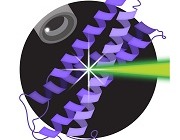A well-known molecular feature that is associated with Parkinson's Disease (PD), is the accumulation of amyloid fibrils of the protein alpha-Synuclein in Lewy bodies, inside dopaminergic neurons of the Substantia Nigra Pars Compacta. α-Synuclein (α-Syn) is an intrinsically-disordered protein (IDP). As is the case with other IDPs or proteins with intrinsically disordered regions (IDRs), the structurally unstable regions tend to find alternative ways to fold, usually coupled to binding other bio-molecules. In some cases, the alternative folding is coupled to the binding of the same protein in an oligomerization process.
While full amyloid fibrils of α-Syn are considered molecular signatures of PD, specific small-sized oligomers have the capacity to bind to membranes and form many different species, some are important for the proper function of pre-synaptic Dopamine vesicles pores, while others might lead to neuronal toxicity linked to PD. Another feature of this multi-functionality is that some of the structural organizations of α-Syn in these higher-order complexes might be existing also in the ensemble of structures of the free-form α-Syn monomer.
Using multiple single-molecule fluorescences together with high-information content mass-spectrometric techniques and experimentally-restrained structural modeling, we characterize structure models of species of the free-form α-Syn monomer, dimer, other small oligomers and the membrane-bound form of α-Syn and compare the structure models to the ones existing in the α-Syn subunit of higher order organizations. The fine structure of these species assists in the rational design of small molecules that will inhibit or stabilize the formation of specific higher order α-Syn organizations, with the aim to minimize the molecular processes associated with the onset of PD.

See Chen & Zaer et al., bioRxiv 2020; "Chen, Zaer et al. 2021, Structure" (in collaboration with the lab of Prof. Nikolay Dokholyan).

